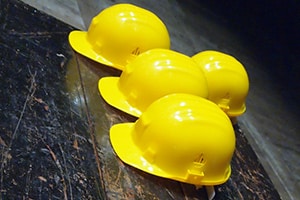Staying Safe in Winter
Jan 07, 2020
If you are a builder, working outside in cold weather is something that can’t be avoided. More than any business, construction is affected by exterior conditions, everything from wind and rain to snow and extreme cold.
It’s important to put in place additional safety procedures during the winter months when you are operating, whether you are a sole trader or work for a construction company.
Avoiding Risk
Once conditions become slightly risky it’s not worth your health and safety to continue working. Builders can often be under pressure to complete a particular job but that doesn’t mean putting yourself in harm’s way. No paycheque is worth risking your health.
Keep an Eye on the Weather
It goes without saying that you need to keep an eye on what’s happening with the weather, even if things start off brightly on the day you are working. If you’re doing something like roof work or are up on scaffolding, the risks are greatly increased during colder, more inclement weather.
You also need to be aware of the shorter days and how the light diminishes so quickly in the afternoon. That means having sufficient artificial lighting available if you want to continue working.
Inspect and Clear Your Site
If snow has fallen or there’s been a storm, you’ll need to inspect your building site before any work commences. You may have to clear snow or grit the ground if a frost has fallen. If you have icy or hazardous areas that you can’t get rid of, make sure they are properly marked.
Following any spell of bad weather, make sure you check infrastructure such as scaffolding to ensure that it has not been compromised.
Use the Right Personal Protective Gear
Most builders understand that it’s important to wear the appropriate gear when working. In the winter, that means having the proper footwear that ensures you don’t slip and keeps your feet warm.
Wearing gloves in cold weather and a hard hat to protect against falling debris are also essential. All the usual equipment such as facemasks, goggles and the like are important too.
If you are wearing protective equipment such as a fall safety rope, make sure that it fits properly over your bulkier winter wear.
Warm Equipment Properly
Many pieces of heavy equipment need to be warmed up properly before being used for building work. The manufacturer’s instructions should contain information about this.
Some equipment, for instance, contains engine or hydraulic oil. Compressors and pneumatic tools also need to be used and maintained appropriately in cold weather. Don’t just assume they are ready to go when you arrive for work in the morning.
Have an Emergency Kit to Hand
If you work in the building trade, it’s important to have access to a decent emergency kit whether it’s winter or not. You might also want to include an emergency weather kit, however, such as a shovel and ice remover as well as road flares, especially if you work regularly out in country areas.
Clothing and Access to a Warm Space
Even when working outside, warmth is still important. Ensure that you wear the right clothing, including a warm pair of socks and waterproof jacket. It’s easy to get into a condition of hypothermia if you are concentrating on a job and it can have a profound effect on your health.
Ensure that your work van heater is working properly and you have that warm space to go to when you need to take a break, rather than standing or sitting outside. Finally, make sure you take on plenty of fluids (preferably warm beverages) and keep your calorific intake up through the working day.